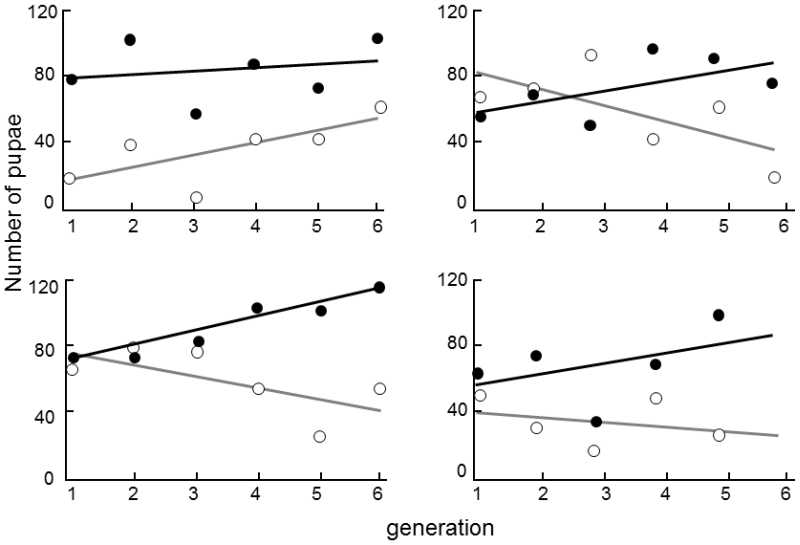XIII.3.1.1.1 The Mills of God model highlights the fact that, by virtue of its higher microevolutionary plasticity, a sexually reproducing species can, in the medium-term, wedge out an asexually reproducing species which takes longer to change
Sexually reproducing species apparently react more slowly to long-term selection pressures than asexually reproducing species exhibiting the same level of polymorphism would react (see IV.9.2).From the viewpoint of the microevolutionary ability, i.e. from the viewpoint of the ability of the population to rapidly adapt to short-term and frequently reversible changes in the environment, greater microevolutionary plasticity, dependent on the ability to generate new genotypes through segregation and recombination and the ability to maintain polymorphism in the population in the long term (see below), is of quite fundamental importance.
When experimenters allowed drosophila of two strains to compete in a single vessel, where one of the strains was fitter at the beginning of the experiment, but could not respond evolutionarily to evolutionary changes in the members of the other strain, as all the progeny in each generation were replaced by evolutionarily “naive” flies, derived from the stock culture, the strain whose progeny were not replaced by naive individuals acquires twice the fitness in six generations compared to that of the naive competitors (Becerra, Brichette, & Garcia 1999)(Fig. XIII.3).The speed of this process indicates that it is quite clear that the source of the relevant evolutionary changes could not have been relatively rare mutations, but only segregation and recombination.The reversibility of these changes was in no way detrimental since the adapted genotypes originated and died away in a similar rate and as long as the particular selection pressure continued, the presence of such a genotype provided the relevant subpopulation with a competitive advantage compared to its competitors. Moreover, when the advantageous genotypes originated due to recombination (not segregation), they even expressed a sort of heritability, namely vanishing heritability.

Fig.XIII.3 Reduction in fitness in drosophilas that were prevented from responding to the evolutionary drives of their competitors. The graphs depict the development of fitness, measured on the basis of the number of pupae in the cultivation vessel in a line of drosophila that could (black points) and could not (light points) respond to the evolutionary moves of their competitors. In all the four parallel experiments, the cultivation vessels contained the same number of pupae of the drosophila line at the beginning of the experiment, i.e. in the zero generation. In each generation, all the pupae of one line were removed from the vessel (they could be differentiated according to the colour of their eyes, which shone through the pupa wrapping) and these pupae were replaced by the same number of pupae from the stock culture. In three of the four experiments, the fitness of the representatives of the “naive” line decreased. In the first experiment, the drosophila of the domestic line apparently learned to utilize some alternative source present in the medium, so that they did not compete with the drosophila of the “naive” line and the number of flies in both lines increased throughout the experiment, i.e. for six generations. Modified according to Becerra et al. (1999).
One of the possible explanations of long-term survival of sexuality in the population is based on the same principle.The relevant model, which we will term the Mills of God model, was first described in detail by J. Maynard Smith (Maynard Smith 1993); however, he attributed authorship to M. Williams and G. Price.According to this model, the newly emerging parthenogenetic mutant originally has twice the fitness of its sexually reproducing competitor.However, wedging out the competitor took many dozens of generations in a large population.During this time, the traits of the members of the parthenogenetic clone did not change much, because the only source of its microevolutionary variability consists in rare mutations.In contrast, a population of sexually reproducing individuals permanently generates genetic variability and thus basically exhibits greater microevolutionary plasticity.Consequently, suitable adaptations are formed in time, allowing it to wedge out the parthenogenetic clone.
